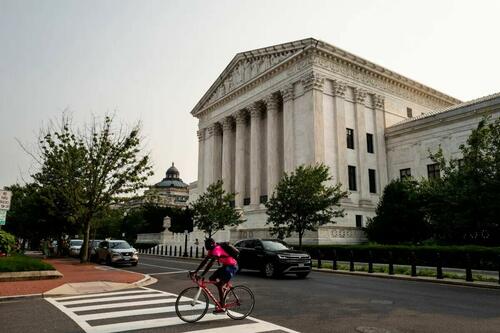
Battle Lines Are Drawn Over Partisan Redistricting – What To Know
Authored by Joseph Lord & Jackson Richman via The Epoch Times (emphasis ours),
As state lawmakers in both parties ponder the possibility of increasing their share of seats in the House through redistricting, some have questioned the legality of the move.
 (Left) California Gov. Gavin Newsom speaks in Sacramento on July 25, 2025. (Right) Texas Gov. Greg Abbott speaks in Beaumont, Texas, on Oct. 17, 2022. Justin Sullivan, Brandon Bell/Getty Images
(Left) California Gov. Gavin Newsom speaks in Sacramento on July 25, 2025. (Right) Texas Gov. Greg Abbott speaks in Beaumont, Texas, on Oct. 17, 2022. Justin Sullivan, Brandon Bell/Getty ImagesThe current situation kicked off in June, after Texas Gov. Greg Abbott called a special session of the Texas Legislature that would, among other goals, consider the prospect of redistricting the state’s congressional seats to more heavily favor Republicans.
President Donald Trump’s administration, through the Department of Justice (DOJ), has encouraged this redistricting, claiming that some of Texas’s districts are illegal under the Voting Rights Act, civil rights legislation designed to increase participation in federal elections and prevent discriminatory or race-based voting restrictions.
Now, lawmakers in the blue states of New York, California, and Illinois are considering a response in kind to increase their own share of the House—while red states like Ohio, Florida, Indiana, and others are considering following Texas’s lead.
But there are hurdles, both legal and political.
Some Americans view the push as blatant partisan gerrymandering—and some legal experts think moving forward is a mistake.
Here’s what to know about the legal basis of the redistricting pushes nationwide.
Gerrymandering
The issue has prompted many to claim that one or both parties is attempting to make partisan gains through a strategic redrawing of the congressional map—behavior known colloquially as “gerrymandering.”
Often, districts are described as “gerrymandered” when they are in an odd or unusual shape that seems designed to ensure a particular outcome.
The term originated in the United States in the early 19th century, and is derived from the name of former Massachusetts Gov. Elbridge Gerry’s salamander-shaped district.
According to a 2022 poll by The Economist and YouGov, two-thirds of Americans considered gerrymandering to be a “major problem” in the United States, with only 23 percent describing it as a “minor problem.”
However, the legality of such behavior is a different question.
Constitutional Basis
As a core constitutional question, redistricting in the middle of the decade is permitted under the law.
In the Constitution’s so-called “Elections Clause,” state legislatures are given a degree of power over “the Times, Places and Manner of holding Elections for Senators and Representatives.” However, that clause also gives Congress the power to “at any time by Law make or alter such Regulations.”
This is a power the Congress has exercised often, through legislation such as the Voting Rights Act and the National Voter Registration Act. But the states retain at least one major power over the process: the drawing of congressional maps.
“Congress can set the time, place, and manner of elections, but as far as the districts themselves, those are drawn by the states,” Neama Rahmani, a lawyer who observes and commentates on national politics, told The Epoch Times.
In short, while states do not get to choose the number of seats they claim in the House—these seats are awarded based on population—states do have the power to determine how their congressional seats are awarded, the shape of the congressional districts, and other factors related to the state’s House delegation.
In some states, this power has been used for partisan purposes and handled by state legislatures, while other states rely on independent commissions or bipartisan districting processes.
In 2006, the Supreme Court affirmed in League of United Latin American Citizens (LULAC) v. Perry that gerrymandering for partisan gain is not inherently unconstitutional or a violation of the Voting Rights Act.
 The U.S. Supreme Court in Washington on June 3, 2025. Madalina Vasiliu/The Epoch Times
The U.S. Supreme Court in Washington on June 3, 2025. Madalina Vasiliu/The Epoch TimesThe issue at hand was Texas’s mid-decade redistricting carried out in 2003. The goal of that redistricting was to increase Republicans’ control of the House delegation.
State-Level Challenges
While the move may be technically legal under Supreme Court precedent, challenges remain, particularly on a state-by-state level.
In Texas, where Republicans hope to add as many as five new seats, the Legislature is currently gridlocked after at least 51 Democrats fled the state, depriving the Texas House of a quorum to move forward on the push.
Rahmani said that this is likely only “delaying the inevitable” in Texas.
If Texas does move forward, Rahmani said that it likely wouldn’t be impossible for Democrats to respond in kind, particularly in dark-blue states like California.
California Gov. Gavin Newsom has said his team is looking at the possibility of changing the state’s maps—which are currently drawn by an independent commission—via a referendum of the people of California.
 Gov. Gavin Newsom speaks in Downey, Calif., on July 16, 2025. Patrick T. Fallon/AFP via Getty Images
Gov. Gavin Newsom speaks in Downey, Calif., on July 16, 2025. Patrick T. Fallon/AFP via Getty ImagesThe referendum would have voters accept or reject a redrawn map during the 2026 midterm elections, allowing the new map to go into effect in later elections.
“California is a heavily blue state throwing a lot of money at this. You can win any ballot initiative here,” Rahmani said.
Currently, Democrats control 43 of the Golden State’s 52 congressional seats.
Other states considering redistricting could face similar hurdles—but ultimately, Rahmani said, none of these will be insurmountable if states are determined to move forward.
In red states with legislatures and governors’ mansions controlled by the GOP, he said, “there’s nothing Democrats in the state can do to stop it.”
Likewise, Rahmani said, “California can do the same, even if there is a law on the books that prohibits this. Those laws can be changed, and especially when you have the [ballot] initiative process.”
Political Question
With many Americans opposed to gerrymandering, and with potentially dire consequences for the political system and rule of law, experts say that the question isn’t just a legal one, but also a political one.
Misha Tseytlin, a lawyer who specializes in political law, told The Epoch Times that in “some states the hurdles would be political, not legal. New York and California, for example, would require constitutional amendments adopted by the people of each state.”
While these hurdles likely aren’t insurmountable, Rahmani said, “I don’t think it’s the right thing to do.”
“It’s going to result in retaliation. It’s going to result in even more extreme candidates being elected to Congress, and gridlock in Congress, because all of a sudden you’re not going to have any purple districts. There’s going to be no more moderates,” Rahmani said.
“So I think this is a bad idea politically, and it’s just going to result in retaliation on the other side.”
Rahmani expressed particular concern about the prospect that Americans could lose faith in the political process if redistricting moves forward.
“If people think that they’re not represented in Congress … it’s going to end up being a problem,” Rahmani said.
Rep. Mike Lawler (R-N.Y.), considered a moderate in his purple New York district, has also expressed reservations about his party’s push in Texas and elsewhere.
“I think it’s wrong, what Texas is doing,” he said on CNN. “I don’t support it.”
Tyler Durden
Sat, 08/09/2025 – 19:50












